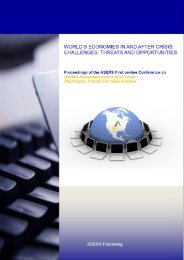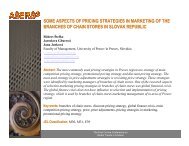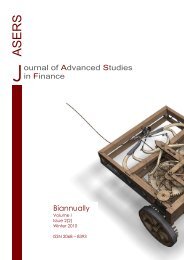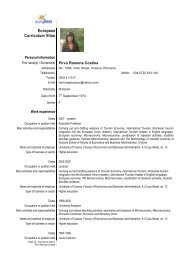Can Shift to a Funded Pension System Affect - ASERS
Can Shift to a Funded Pension System Affect - ASERS
Can Shift to a Funded Pension System Affect - ASERS
You also want an ePaper? Increase the reach of your titles
YUMPU automatically turns print PDFs into web optimized ePapers that Google loves.
Theoretical and Practical Research in Economic Fields<br />
For this reason, the estimate gained with the Taylor Rule can be influenced by the initial estimate of the<br />
output gap. The use of different time series <strong>to</strong> obtain the output gap, or a different method for calculating the<br />
natural level of output, can affect the final results. It could be possible that an economist starts a work with an<br />
original error.<br />
Moreover, it is common <strong>to</strong> substitute the gross domestic product with the industrial production as a proxy<br />
of the output. And so, many economists estimate a natural level of the industrial production and an industrial<br />
production gap through the use of the Hodrick Prescott filter on this type of time series and they use this type of<br />
gap in the Taylor Rule.<br />
In this paper, in order <strong>to</strong> eliminate this initial problems, I have used a different and simpler way <strong>to</strong> estimate<br />
the output gap: I do not substitute the gross domestic product time series with other time series and I do not make<br />
use of any type of filter.<br />
Analyzing the attitude of the ECB <strong>to</strong>wards the economic framework, I have supposed that a quarterly GDP<br />
growth between 0.5 and 0.6% could be considered as an inflation-neutral speed growth. We can see at this range<br />
as a natural and non-inflationary economic growth. I suppose that the ECB moves the nominal interest rate if the<br />
quarterly GDP growth is above or below this specific range only. It is clear that this type of method is really<br />
simple: for example, a quarterly GDP growth above 0.6% could represent a threat for price stability and so the<br />
ECB is induced <strong>to</strong> move nominal interest rate adopting a tighter monetary policy. Using this simple method it is<br />
possible not <strong>to</strong> use preliminary estimates (i.e. estimates on GDP trend or other type of calculation in order <strong>to</strong><br />
obtain an output gap) before testing the Taylor Rule. Furthermore, this method has given very good results, as<br />
one can see in the next sections. In next sections I refer <strong>to</strong> this indica<strong>to</strong>r as the GDP gap.<br />
4. Initial findings<br />
As I have said before, in this first section I use a backward looking Taylor Rule and the estimates are<br />
obtained with OLS regressions. I use the day-<strong>to</strong>-day rate as dependent variable. The sample examined in the<br />
paper starts in January 1999 and ends in August 2007. I decided <strong>to</strong> disregard the first period of the crisis. I got<br />
data on GDP, inflation and Euro-Dollar exchange rate from Eurostat‟s website and those on monetary aggregate<br />
M3 from the ECB‟s website.<br />
Inflation data are monthly. I have transformed the GDP data from quarterly <strong>to</strong> monthly with a simple<br />
method. I have applied the GDP quarterly growth <strong>to</strong> each month of that quarterly. The quarterly GDP growth<br />
indicates the increase of the GDP over a period of three months in comparison with the previous three months. It<br />
means that, on average, the monthly amount of GDP is increased with the same pace. For example, if we<br />
recognize a 0,5% quarterly GDP growth in the second quarter of a year, we can assume that in each month of<br />
that quarter (April, May, June) there has respectively been a 0,5% GDP growth in comparison with the first,<br />
second and third month of the previous quarter (January, February, March). Through this simple approach I have<br />
transformed my GDP gap quarterly data in GDP gap monthly data. Then, if we consider the gap between actual<br />
value of GDP growth (gdp%) and the natural range of growth (0,5%÷0,6%= gdp%*, see the previous section) we<br />
can obtain the GDP gap for a single month. In the rest of the paper I will call this gap GDP gap (= gdp% - gdp%*)<br />
and I will use this value in the estimates of the Taylor Rule.<br />
As regards the lags, the ECB Council decides the path of the MRO rate during the meetings held the first<br />
Thursday of each month. So, it is really impossible that the ECB has contemporaneous values of output gap and<br />
inflation gap at disposal (this is the original prevision made by Taylor, 1993). For this reason I decided <strong>to</strong> use two<br />
lags for the inflation rate and 4 lags for the GDP gap. Indeed, it seems plausible that at the beginning of a month<br />
the ECB knows the value of the inflation gap of two month before. For the GDP I have considered the great<br />
difficulty <strong>to</strong> calculate this indica<strong>to</strong>r and the delay of its release.<br />
The resulting formula is:<br />
i<br />
t<br />
(2)<br />
<br />
0<br />
1( t<br />
2<br />
<br />
) 2xt<br />
4<br />
The results of the first estimation are shown in Table 1.<br />
Coefficients on inflation gap and on GDP gap are significant, but the values of these coefficients and the<br />
value of the R 2 statistic indicate that this initial estimate does not have a great economic significance. Coefficient<br />
on inflation gap (inflgap_2) has a value slightly below 0,60. This is a little value compared <strong>to</strong> the major empirical<br />
work or <strong>to</strong> the optimal value suggested by the dominant economic theory (see, for example, Clarida, Gertler, and<br />
Galì 1998), even if this value, according <strong>to</strong> the work of Ball (1999), is fully acceptable. This value implies that the<br />
44











